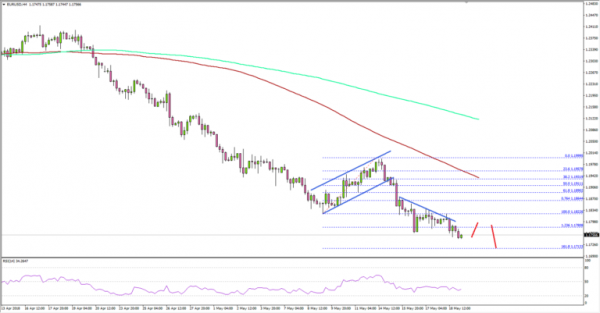Key Highlights
- The Euro faced an increased selling pressure recently and declined below 1.1800 against the US Dollar.
- There is a short-term connecting bearish trend line forming with resistance at 1.1800 on the 4-hours chart of EUR/USD.
- Euro Area’s Trade Balance in March 2018 posted a trade surplus of €21.2B, more than the forecast of €20.7B.
- Canada’s CPI in April 2018 increased 0.3% (MoM), less than the forecast of 0.4%.
EURUSD Technical Analysis
The Euro came under a lot of bearish pressure this past week and declined below 1.1880 support against the US Dollar. The EUR/USD pair accelerated declines and even closed the week below 1.1800.
Looking at the 4-hours chart, the pair is clearly in a downtrend from the 1.1999 swing high. During the downside, the pair broke an ascending channel with support at 1.1930. It opened the doors for more losses and the pair tumbled below the last swing low of 1.1822.
The pair even broke the 1.236 Fib extension of the last wave from the 1.1822 low to 1.1999 high. It seems like the pair may continue to move down and it could even break the 1.1720 support.
The next stop for sellers could be the 1.618 Fib extension of the last wave from the 1.1822 low to 1.1999 high. On the upside, there is a short-term connecting bearish trend line forming with resistance at 1.1800 on the 4-hours chart of EUR/USD.
As long as the pair is below 1.1800 and 1.1820, it remains at a risk of more losses in the near term.
Other major pairs such as GBP/USD also remained in a bearish zone this past week below 1.3550. On the other hand, USD/JPY jumped higher and traded above the 110.50 level.
The overall bias is positive for the US Dollar, suggesting more declines or limited upsides in the Euro, British Pound and the Japanese Yen.















